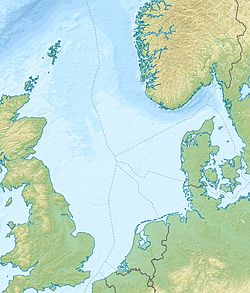Top Qs
Timeline
Chat
Perspective
Gorm Field
Natural gas and oilfield in the North Sea From Wikipedia, the free encyclopedia
Remove ads
Gorm is a natural gas and oilfield in the Danish Sector of the North Sea. It was discovered in 1971 and is the largest oilfield exploited by Denmark.[1] The production infrastructure consists of five bridge-linked platforms[2] and is operated by BlueNord. The facilities include two wellhead platforms and several processing platforms. The Rolf and Dagmar fields are satellites to Gorm.
Remove ads
Reservoir
The reservoir properties of the Gorm field are as shown.
Remove ads
Infrastructure
Summarize
Perspective
Installations
The installations developed for the Gorm field were as follows. The water depth at the site is 39 metres.[3]
In 2014 there were 32 oil production wells, one gas injection well, and 14 water injection wells.[4]
Pipelines
A number of pipelines transport fluids to and from the Gorm field. The Skjold, Rolf and Dagmar fields are satellites of Gorn
Note. CALM = Catenary Anchor Leg Mooring; buoys used to load ships with oil before the export pipeline was available.
Remove ads
Production
The original design production rate for the process facilities on Gorm C was 60,000 barrels of oil per day (bopd). The design gas injection rate was 84 mmscfd (million standard cubic feet per day). The pumping platform Gorm C had a design throughput of 90,000 bopd.[3]
The production strategy is to maintain reservoir pressure through water injection.[4]
The production data for the Gorm field is shown in the following table. Production and injection numbers are cumulative rates up to 1 January 2014. About 400 barrels per day (64 m3/d) of crude oil from the nearby Rolf oil field are processed on the Gorm platforms.[6]
In 2014 the annual production was 6.3 million barrels of oil and 3,677 million standard cubic feet of gas (104 million m3 gas).[5]
Incidents
Dagmar and Rolf fields
Summarize
Perspective
The Dagmar and Rolf fields are satellites to the Gorm installations. The characteristics of the fields are as follows.
| Field | Dagmar | Rolf |
| Prospect | East Rosa | Mid Rosa |
| Reservoir | Chalk and Dolomite | Chalk |
| Geological age | Danian, Upper Cretaceous and Zechstein | Danian and Upper Cretaceous |
| Coordinates | 55.576474°N 4.618248°E | 55.605986°N 4.491481°E |
| Block | 5504/15 | 5504/14 & 15 |
| Reservoir depth | 1,400 m | 1,800 m |
| Field delineation | 50 km2 | 22 km2 |
| Reserves | ||
| Discovered | 1983 | 1981 |
The fields are developed through two offshore installations as shown.
| Field | Dagmar | Rolf |
| Production start | 1991 | 1986 |
| Water depth | 34 m | 40 m |
| Installation | Fixed steel no helideck | Fixed steel |
| Function | Wellheads no processing | Wellheads no processing |
| Substructure weight tonnes | 500 | 1,400 |
| Topsides weight tonnes | 532 | 1,900 |
| Number of wells | 2 | 3 |
| Status | Shut in 2006 & 2007 | Producing (2022) |
| Export, well fluids | 9 km 8-inch pipeline to Gorm F | 17 km 8-inch pipeline to Gorm E |
| Import, lift gas | - | 17 km 3-inch pipeline from Gorm E |
The oil production profile of the Dagmar and Rolf fields (in 1000 cubic metres) is as shown.
| Year | 1986 | 1987 | 1988 | 1989 | 1990 | 1991 | 1992 | 1993 | 1994 | 1995 | 1996 | 1997 | 1998 | 1999 | 2000 | 2001 | 2002 | 2003 | 2004 |
| Rolf | 469 | 634 | 396 | 395 | 271 | 293 | 304 | 176 | 100 | 130 | 113 | 96 | 92 | 77 | 83 | 51 | 51 | 104 | 107 |
| Dagmar | 475 | 305 | 67 | 33 | 35 | 23 | 17 | 13 | 10 | 8 | 4 | 6 | 7 | 2 |
| Year | 2005 | 2006 | 2007 | 2008 | 2009 | 2010 | 2011 | 2012 | 2013 | 2014 | 2015 | 2016 | 2017 | 2018 | 2019 | 2020 | 2021 | 2022 | Total |
| Rolf | 79 | 89 | 103 | 78 | 76 | 60 | 1 | 78 | 75 | 54 | 47 | 58 | 45 | 45 | 48 | 4876 | |||
| Dagmar | 0 | 0 | 1005 |
Remove ads
See also
References
External links
Wikiwand - on
Seamless Wikipedia browsing. On steroids.
Remove ads
